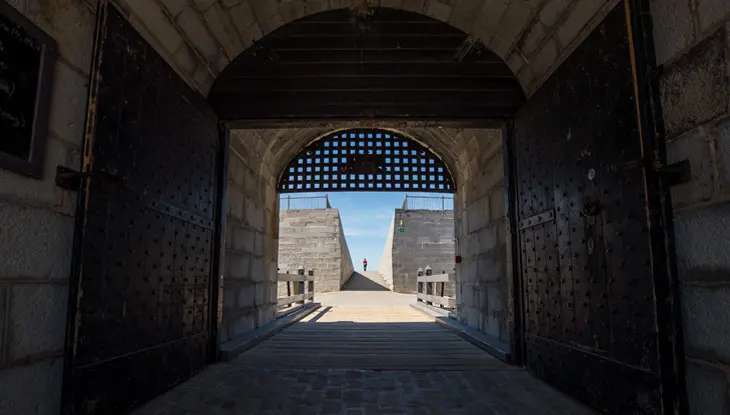Canadian War Museum
The Canadian War Museum is both a museum of the nation’s military history and a place of remembrance for those who served in the past and present.
The fantastic displays guide you through the twists and turns of history within a building designed to portray hope and regeneration. Many of the museum’s displays are interactive and life-sized, emphasizing the human experience of war.
The Canadian War Museum highlights defining moments in Canada’s military history with honesty and respect, and the ways in which past events have shaped the nation.
Canadian War Museum | Ottawa Tourism
How to get to Canadian War Museum
Location: 1 Vimy Place, Ottawa
By car: The War Museum is located in the heart of Ottawa on LeBreton Flats. On-site parking is available. Find driving and transit directions online.
By transit: VIA Rail provides regular train service between Toronto and Ottawa. Take OC Transpo to Pimisi Station, then walk seven minutes north to the museum.
By bicycle: Bike racks are available onsite.
Know before you go
All visitors are required to have a timed ticket for entry. Book timed tickets online or through the Call Centre at 1-800-555-5621. If you have not booked in advance, timed admission tickets are available at the box office on a first-come, first-served basis.
Admission to the museum is free on Thursdays from 5:00 p.m. to 7:00 p.m., but a timed ticket is required.
A limited number of strollers and wheelchairs are available at no charge. Requests can be made at the Information Desk.
Things to do at Canadian War Museum
Discover more activities and experiences.
Explore military technology
Showcasing many large military weapons, vehicles and equipment from its extensive collection, the LeBreton Gallery is an open-storage space that tells the human experience of war.
Immerse yourself in history
Learn about Canadian history through the museum’s exhibitions. Special exhibits and galleries cover themes ranging from pre-contact warfare and colonial wars to the present day.
Follow a museum tour
Join a scheduled public tour for an in-depth look at Canadian military history. Program interpreters lead groups through the galleries, making the spaces and stories come to life.
Stop at the gift shop
Commemorate your time at the museum with a souvenir from the gift shop. Explore military models, books, home decor and accessories, plus one-of-a-kind items made by Canadian artisans.
Grab a bite to eat
Stop by The Cafe inside the Canadian War Museum, featuring new and diverse creations by the in-house chef. Feast on fresh salads, creative sandwiches, pizza, poutine, burgers and more.
Discover history from home
Learn about Canada’s military history from your own home. The museum’s online exhibitions cover Canada’s role in the First World War, naval history, Remembrance Day and more.
Articles and itineraries
Get ideas and inspiration for your next trip.

Interesting facts about the Canadian War Museum
Designed by Canadian architect Raymond Moriyama, the Canadian War Museum is inspired by the idea of regeneration. The building looks like it’s emerging from the earth, and its surrounding landscape is inspired by First World War battlefields. Walking up to the roof, you’ll see grass growing everywhere, representing nature healing the earth.
At the top of the building, a series of small windows representing Morse code letters spell out “Les we forget” in English and French.
Each year at 11:00 a.m. on Remembrance Day, a single window in Memorial Hall illuminates the headstone of the Unknown Solider.
Accessibility features
Accessible recreation trails
Trails with a firm and stable surface, designed to be accessible for individuals of all abilities. These trails are intended for public use, offering opportunities for leisure and recreation. To qualify as an accessible recreational trail, your site must have at least one such trail that is regularly maintained.
Accessible parking space
Accessible parking provides a place for people with disabilities to park and space to get in and out of their vehicles safely. It also provides access to the main accessible entrance and/or any other accessible entrances. Most users of wheelchairs need at least three feet of clearance to get in and out of their vehicles.
Wide doorways and hallways
A sufficiently wide, hard-surfaced, unobstructed path to allow for easy travel.
Accessible washroom
At least one washroom stall larger than the others to accommodate adequate maneuvering space for mobility devices. They also include grab bars, transfer space, an accessible door latch, sink with knee clearance, and lever handles or automatic sensor faucets.
Wheelchair and/or mobility devices available
Mobility devices such as wheelchairs, walkers, canes or mobility scooters are available for people to borrow or rent at the business. If you make wheelchairs or assistive devices available to the public, it is important to make sure that they are properly maintained and periodically serviced so they are in good working order and do not present a safety risk.
Evacuation chairs
Compact and foldable mobile chairs used to evacuate people with disabilities down the stairs. Evacuation chairs may be manually operated or have a battery-powered motor.
Last updated: November 3, 2025






